Questioning the Changes Data Sheet 1-29
FM Global is a business property insurer, providing insurance and loss prevention engineering services to its clients. FM Approvals is a business unit of FM Global charged with testing materials and systems certifying that they meet its standards.

FM Global is a business property insurer, providing insurance and loss prevention engineering services to its clients. FM Approvals is a business unit of FM Global charged with testing materials and systems certifying that they meet its standards. FM Approvals bills itself as a nonprofit group, but as such it is dependent on revenue from testing and evaluation of various building system components (including roof systems). When suppliers to the roofing industry have completed testing of their latest products and systems, roofing materials testing business at FM Approvals slows down. In January of this year, FM Global made changes to Data Sheet 1-29, which puts forward recommendations relating to the securement of roof decks to roof structures and the design and installation of the roof insulation and membrane systems that cover them. The recent changes made to Data Sheet 1-29 would require additional testing for roofing products and systems.
Much of FM Global's justification for changing the guidelines is based on its reported losses, without any reference to whether or not the losses occurred to roof systems that were not constructed in accordance with the prior guidelines (that is, the guidelines in effect in 2005, before the recent changes).
The fact is that FM Global, like any other company, is always looking for new business. New business often includes the assumption of existing structures whose existing roofs may or may not have been installed in accordance with prior or current FM Global recommendations.
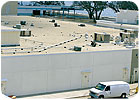 FM Global conducted a "Roofing Industry Forum" on June 22, in which FM Global representatives presented some interesting loss comparison information as the basis for its claim that "about 70 percent of all property losses are due to human factors." In the course of the forum, property loss comparisons were made regarding "improved" versus "unimproved" locations. (In the forum, FM Global representatives indicated that "improved" locations were properties that followed FM Global engineering recommendations for windstorm resistance, while "unimproved" locations were facilities that had FM Global recommendations yet to be completed.). The most recent storm data presented included 2005 incidents during hurricanes Rita and Katrina. The fact that there was an 85 percent reduction in Katrina wind losses and a 75 percent reduction in Rita wind losses would appear to be a good indicator that the prior recommendations contained in Data Sheet 1-29 were sufficient protection against wind losses in all but the most severe storm conditions.
FM Global conducted a "Roofing Industry Forum" on June 22, in which FM Global representatives presented some interesting loss comparison information as the basis for its claim that "about 70 percent of all property losses are due to human factors." In the course of the forum, property loss comparisons were made regarding "improved" versus "unimproved" locations. (In the forum, FM Global representatives indicated that "improved" locations were properties that followed FM Global engineering recommendations for windstorm resistance, while "unimproved" locations were facilities that had FM Global recommendations yet to be completed.). The most recent storm data presented included 2005 incidents during hurricanes Rita and Katrina. The fact that there was an 85 percent reduction in Katrina wind losses and a 75 percent reduction in Rita wind losses would appear to be a good indicator that the prior recommendations contained in Data Sheet 1-29 were sufficient protection against wind losses in all but the most severe storm conditions.
When the data is examined pertaining to roofs installed under the prior guidelines (the ones superceded this year), it seems clear that the changes instituted by FM Global to Data Sheet 1-29 appear to be unwarranted and have little merit in providing better roof system service to those insured by FM Global or those who use Data Sheet 1-29 as a guideline for roof systems.
Analysis of the new FM Global Property Loss Prevention Data Sheet 1-29 seems to show that FM Global used American Society of Civil Engineers (ASCE) Standard 7 ("Minimum Design Loads for Buildings and Other Structures") to compute unrealistically high wind uplift forces. It appears that they have done this by increasing the "importance factor" from 1.0 to 1.15 for all buildings and then rounding up every calculation to the next uplift classification, causing the wind load force prediction at corners to skyrocket (on paper). Essentially, it seems FM Global is convoluting the use of ASCE 7 to provide justification for the recent changes to the guidelines. FM Global's interpretation of ASCE 7 appears to be totally self-serving. And there appears to be no real-world experience factor or even the conduct of controlled testing of roof systems to verify the organization's computations and justify the changes to Data Sheet 1-29.
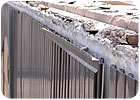
A good tee shot from the front entrance of the mall would land in the Gulf of Mexico (unless the ball hit one of the remaining trees). Most of the other roofs on the mall were heavily damaged or AWOL, wrapped around the remainder of the trees in the bayous, but the roofs constructed in accordance with then current (now prior) FM Global recommendations (the built-up roof on the mall and the Sarnafil mechanically attached roof on the Sears store) suffered no more damage than the displacement of one small roof-mounted A/C compressor and minor flashing damage on the PVC roof.
We had a similar experience in Spanish Fort, Ala., where some metal wall panels and flat tile were displaced during the storm, but the low-sloped roofs constructed to prior FM Global recommendations sustained no damage other than punctures caused by wind-blown debris. Is it really necessary to change the rules?
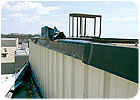 In another example from times past, two virtually identical department stores were constructed along I-45 in Houston at approximately the same time. An architect was responsible for the design of one roof, which was constructed with one layer of Fiberglas roof insulation adhered to the steel roof deck with hot asphalt covered by a gravel surfaced built-up roofing membrane. A proprietary coping system was used at the top of parapet walls approximately 24 inches high. Working on behalf of the owner, we had significant input into the design of the roof on the second facility, approximately five miles south in another mall. The roof system on the second facility was constructed in general compliance with FM Global recommendations in effect at the time over a 22-gauge painted intermediate rib steel roof deck on steel joists secured in accordance with then Data Sheet 1-28, a base layer of Fiberglas roof insulation was 100 percent mechanically attached to 1-90 recommendations, a top layer of Fiberglas roof insulation installed in a continuous mopping of hot Steep Grade asphalt, and a four-ply glass fiber reinforced asphalt built-up roofing membrane with Type I asphalt and gravel surfacing. Shop fabricated coping metal was secured on the face with a 20-gauge galvanized steel hook strip and fastened with screw fasteners on the inside vertical section.
In another example from times past, two virtually identical department stores were constructed along I-45 in Houston at approximately the same time. An architect was responsible for the design of one roof, which was constructed with one layer of Fiberglas roof insulation adhered to the steel roof deck with hot asphalt covered by a gravel surfaced built-up roofing membrane. A proprietary coping system was used at the top of parapet walls approximately 24 inches high. Working on behalf of the owner, we had significant input into the design of the roof on the second facility, approximately five miles south in another mall. The roof system on the second facility was constructed in general compliance with FM Global recommendations in effect at the time over a 22-gauge painted intermediate rib steel roof deck on steel joists secured in accordance with then Data Sheet 1-28, a base layer of Fiberglas roof insulation was 100 percent mechanically attached to 1-90 recommendations, a top layer of Fiberglas roof insulation installed in a continuous mopping of hot Steep Grade asphalt, and a four-ply glass fiber reinforced asphalt built-up roofing membrane with Type I asphalt and gravel surfacing. Shop fabricated coping metal was secured on the face with a 20-gauge galvanized steel hook strip and fastened with screw fasteners on the inside vertical section.
When the hurricane came through Houston, most of the architect's roof left the county for parts unknown, leaving the facility flooded and out of commission for the better part of six months. The roof system constructed in accordance with the FM Global's recommendations then in effect had "cones" of gravel near the perimeter where tornadic wind action had displaced the loose aggregate, and one section of shop fabricated metal coping was gone from the southeast corner of the building. There was no other damage to the roof system caused by the storm. It was interesting that the top course of CMU left the premises with the metal coping section still attached.
We constructed another roof in Homestead, Fla., after hurricane Andrew. It was installed to FM Global recommendations for 1-90 windstorm resistance, except the 24-gauge stainless steel perimeter metal was secured by an 18-gauge galvanized steel hook strip with screw fasteners on the inside vertical section. That facility has since been assaulted by five other hurricanes, which have caused no damage to the roof system installed in accordance with the then current FM Global recommendations. It might also be noted that the APP modified asphalt roof membrane system was "adhesive" applied - a system that Dade County, Fla., still will not recognize as "acceptable."
Do I believe that the previous FM Global Research recommendations were effective? You can bet on that! Do I believe that new guidelines are necessary or that the existing "rules" should be arbitrarily changed by FM Global? Certainly not, based on my personal experience.
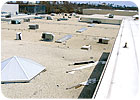
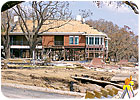 In light of the fact that objective observations indicate that we know how to build roof systems to be storm-resistant, why change the rules? Why don't we just enforce or use the rules we have that we know work? I've already opined on that topic based on real-world evaluation. It is incumbent on FM Global do a more thorough job of evaluating the roof systems that they assume with a new client to minimize their losses. Why should the roofing industry pay FM Approvals to test new systems when current roof system criteria are effective?
In light of the fact that objective observations indicate that we know how to build roof systems to be storm-resistant, why change the rules? Why don't we just enforce or use the rules we have that we know work? I've already opined on that topic based on real-world evaluation. It is incumbent on FM Global do a more thorough job of evaluating the roof systems that they assume with a new client to minimize their losses. Why should the roofing industry pay FM Approvals to test new systems when current roof system criteria are effective?
I've made the comment before that FM Global wants to build storm-proof roofs, not just storm-resistant roofs. That might be an admirable goal, but I've always maintained that you can't mess with Mother Nature - she will have the last word. If FM Global could pull off the storm-proof roof, the house would blow down and the intact roof system would come down on top of it.
The changes made by FM Global to Data Sheet 1-29 would appear unjustified and not in the best interest of the roofing community (which will be able to offer fewer options in some portions of the country) or the consumer (as they increase cost).
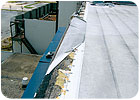 Some of the new guidelines actually are detrimental to the potential long-term serviceability of the roof systems, as they could result in problems such as fasteners in less than optimal positions in the roof membrane, thermal bridging into the core of the roof membrane, and puncture damage from uninsulated fastener heads in heavy traffic areas.
Some of the new guidelines actually are detrimental to the potential long-term serviceability of the roof systems, as they could result in problems such as fasteners in less than optimal positions in the roof membrane, thermal bridging into the core of the roof membrane, and puncture damage from uninsulated fastener heads in heavy traffic areas.
Kudos to the old Factory Mutual System for providing the initial guidelines to improve the wind uplift resistance of roofing systems, but it appears that the current "over-engineering" by FM Global is a step backward when it comes to providing technically sound roofing systems.
The old adage "If it ain't broke, why fix it?" appears appropriate in this case. FM Global can certainly go it's own way, but a significant backlash from the roofing industry should be anticipated. We currently have all the guidelines necessary to build storm-resistant roof systems. I will never (nor will my grandsons) live to see the storm-proof roof!

FM Global is a business property insurer, providing insurance and loss prevention engineering services to its clients. FM Approvals is a business unit of FM Global charged with testing materials and systems certifying that they meet its standards. FM Approvals bills itself as a nonprofit group, but as such it is dependent on revenue from testing and evaluation of various building system components (including roof systems). When suppliers to the roofing industry have completed testing of their latest products and systems, roofing materials testing business at FM Approvals slows down. In January of this year, FM Global made changes to Data Sheet 1-29, which puts forward recommendations relating to the securement of roof decks to roof structures and the design and installation of the roof insulation and membrane systems that cover them. The recent changes made to Data Sheet 1-29 would require additional testing for roofing products and systems.
Much of FM Global's justification for changing the guidelines is based on its reported losses, without any reference to whether or not the losses occurred to roof systems that were not constructed in accordance with the prior guidelines (that is, the guidelines in effect in 2005, before the recent changes).
The fact is that FM Global, like any other company, is always looking for new business. New business often includes the assumption of existing structures whose existing roofs may or may not have been installed in accordance with prior or current FM Global recommendations.

The Edgewater Mall in Biloxi, Miss., is seen in the aftermath of Hurricane Katrina with the Gulf of Mexico visible in the background. The commons section, reroofed two years ago, is shown here, along with a Sears store in the upper left.
When the data is examined pertaining to roofs installed under the prior guidelines (the ones superceded this year), it seems clear that the changes instituted by FM Global to Data Sheet 1-29 appear to be unwarranted and have little merit in providing better roof system service to those insured by FM Global or those who use Data Sheet 1-29 as a guideline for roof systems.
Analysis of the new FM Global Property Loss Prevention Data Sheet 1-29 seems to show that FM Global used American Society of Civil Engineers (ASCE) Standard 7 ("Minimum Design Loads for Buildings and Other Structures") to compute unrealistically high wind uplift forces. It appears that they have done this by increasing the "importance factor" from 1.0 to 1.15 for all buildings and then rounding up every calculation to the next uplift classification, causing the wind load force prediction at corners to skyrocket (on paper). Essentially, it seems FM Global is convoluting the use of ASCE 7 to provide justification for the recent changes to the guidelines. FM Global's interpretation of ASCE 7 appears to be totally self-serving. And there appears to be no real-world experience factor or even the conduct of controlled testing of roof systems to verify the organization's computations and justify the changes to Data Sheet 1-29.

Older sections of the mall roof sustained damage at the perimeters. Several sections lost roof membrane during Hurricane Katrina.
Previous Guidelines Effective
In my experience, FM Global's previous recommendations are sufficient to build storm-resistant roof systems. The recent photographs included in this article are relatively self-explanatory; they document the latest hurricane incident in the Gulf of Mexico and in Biloxi, Miss., in particular. There was major damage to Biloxi last fall caused by hurricane-force winds and storm surge. Two years prior, a section of the Edgewater Mall was reroofed in compliance with then current FM Global recommendations. The restoration included replacement of the light gauge form deck originally installed at the time of construction with 20-gauge galvanized steel roof deck secured to existing steel joists with Tec screws in accordance with FM Global recommendations. The installation included new steel support at roof perimeters and around large roof-mounted HVAC equipment, mechanical attachment of a base layer of isocyanurate foam roof insulation to FM Global 1-90 recommendations, a cover layer of perlite roof insulation set in a continuous mopping of hot Steep Grade asphalt, and a four-ply glass fiber reinforced built-up roofing membrane with a Type I asphalt and gravel surface. Accessory metal was installed in general compliance with FM Global Loss Prevention Data Sheet 1-49, with gutters on the penthouse strapped 10 feet on center to the elevation wall and hook strips on low-profile edge metal calculated and designed in accordance with FM Global recommendations contained in Data Sheet 1-49.A good tee shot from the front entrance of the mall would land in the Gulf of Mexico (unless the ball hit one of the remaining trees). Most of the other roofs on the mall were heavily damaged or AWOL, wrapped around the remainder of the trees in the bayous, but the roofs constructed in accordance with then current (now prior) FM Global recommendations (the built-up roof on the mall and the Sarnafil mechanically attached roof on the Sears store) suffered no more damage than the displacement of one small roof-mounted A/C compressor and minor flashing damage on the PVC roof.
We had a similar experience in Spanish Fort, Ala., where some metal wall panels and flat tile were displaced during the storm, but the low-sloped roofs constructed to prior FM Global recommendations sustained no damage other than punctures caused by wind-blown debris. Is it really necessary to change the rules?

The Dillard's store at the Edgewater Mall sustained perimeter roof damage.
When the hurricane came through Houston, most of the architect's roof left the county for parts unknown, leaving the facility flooded and out of commission for the better part of six months. The roof system constructed in accordance with the FM Global's recommendations then in effect had "cones" of gravel near the perimeter where tornadic wind action had displaced the loose aggregate, and one section of shop fabricated metal coping was gone from the southeast corner of the building. There was no other damage to the roof system caused by the storm. It was interesting that the top course of CMU left the premises with the metal coping section still attached.
We constructed another roof in Homestead, Fla., after hurricane Andrew. It was installed to FM Global recommendations for 1-90 windstorm resistance, except the 24-gauge stainless steel perimeter metal was secured by an 18-gauge galvanized steel hook strip with screw fasteners on the inside vertical section. That facility has since been assaulted by five other hurricanes, which have caused no damage to the roof system installed in accordance with the then current FM Global recommendations. It might also be noted that the APP modified asphalt roof membrane system was "adhesive" applied - a system that Dade County, Fla., still will not recognize as "acceptable."
Do I believe that the previous FM Global Research recommendations were effective? You can bet on that! Do I believe that new guidelines are necessary or that the existing "rules" should be arbitrarily changed by FM Global? Certainly not, based on my personal experience.

This section of the Edgewater Mall's roof assembly, photographed after Katrina went through, was installed prior to FM Global's recommendation for a 1-90 roof system.
Some Real-World Rules of Thumb
My observations based on the past 20 or so years of post-storm inspections can be summarized rather succinctly.- If perimeter metal stays in place, the roof system will probably remain in place.
- Roof systems installed in general compliance with FM Global and NRCA recommendations rarely are catastrophically affected by storms; there may be some minor damage caused by wind-blown debris, but the overall roof systems generally remain serviceable and repairable.
- All types of roof systems perform reasonably well during major storms if properly installed to the previous FM Global guidelines (those in place in 2005) and current NRCA recommendations.

This structure adjacent to the Edgewater Mall reveals significant damage in the aftermath of Katrina.
I've made the comment before that FM Global wants to build storm-proof roofs, not just storm-resistant roofs. That might be an admirable goal, but I've always maintained that you can't mess with Mother Nature - she will have the last word. If FM Global could pull off the storm-proof roof, the house would blow down and the intact roof system would come down on top of it.
The changes made by FM Global to Data Sheet 1-29 would appear unjustified and not in the best interest of the roofing community (which will be able to offer fewer options in some portions of the country) or the consumer (as they increase cost).

Perimeter roof damage is evident in this section of the Edgewater Mall.
Kudos to the old Factory Mutual System for providing the initial guidelines to improve the wind uplift resistance of roofing systems, but it appears that the current "over-engineering" by FM Global is a step backward when it comes to providing technically sound roofing systems.
The old adage "If it ain't broke, why fix it?" appears appropriate in this case. FM Global can certainly go it's own way, but a significant backlash from the roofing industry should be anticipated. We currently have all the guidelines necessary to build storm-resistant roof systems. I will never (nor will my grandsons) live to see the storm-proof roof!
Looking for a reprint of this article?
From high-res PDFs to custom plaques, order your copy today!



